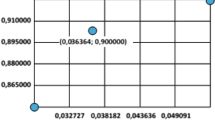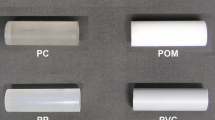Abstract
Certain laws of similarity must be observed in structural-model analyses. In this paper, one aspect of model similarity—that of linearity—is examined quite extensively.
Most model analyses assume that both prototype and model materials obey Hooke's law. But the plastics often used for structural or photoelastic models are viscoelastic or photoviscoelastic. The stress-strain and stress-birefringence relations are time dependent and may be nonlinear. Through careful calibration of model materials and proper design of model tests, potential errors due to the time dependence of material properties can usually be avoided.
If the results of the test are to be interpreted conveniently and accurately, the stresses in the model material must be within the linear range. This range is limited and time dependent for most plastics. The linear range may extend only to stresses considerably below the ultimate or fracture strength of the material. Hence, analyses based don linearity may be in error if the initial stresses are too high and/or if given stresses are sustained too long before desired information is collected.
The stresses which limit the linear range, called linear limit stresses, were determined for both stress-strain and stress-birefringence relations for four commonly used plastics: CR-39 (Cast Optics Co.), PS-1 and PS-2 (Photolastic, Inc.) and P6-K (B.A.S.F., Germany). A graphical presentation of the time-dependent photoelastic and mechanical properties is employed.
It was concluded that linear limit stresses for birefringence are approximately equal to those based on strain and can therefore be used to establish, within reasonable bounds of accuracy, the linear range of behavior of the material.
Similar content being viewed by others
Abbreviations
- D(t) :
-
extension compliance
- d :
-
thickness of model
- m :
-
order of isochromatic
- m :
-
(relative retardation)/(wavelength)
- P :
-
loading force
- t :
-
time
- ε:
-
strain
- λ:
-
wavelength of radiation
- σ:
-
stress
- m(σll)1.0:
-
linear limit stress value at 1.0-percent deviation from linearity for birefringence
- ∈(σll)1.0:
-
linear limit stress value at 1.0-percent devilation from linearity for strain
- S(t) :
-
time-varying birefringence for unit sustained uniaxial stress
- S σ :
-
stress-optical material coefficient
- S ε :
-
strain-optical material coefficient
- Δn=n 1−n 2 :
-
difference of the inices of refraction
Bibliography
Alfey, T., Mechanical Behavior of High Polymers, Interscience Publishers, Inc., New York (1948).
Coolidge, D. J., Jr., “An Investigation of the Mechanical and Stress-Optical Properties of Columbia Resin, CR-39,” Proc. SESA, 74–82 (1948).
Frocht, M. M., Protoelasticity,I and II,John Wiley & Sons, Inc.,New York (1941).
Hiltscher, R., “Spannungsgoptische Untersuchung elastoplasticher Spannungszustande,” ZVDI,95 (23) (1953).
Kiesling, E. W., “Nonlinear, Quasi-Static Behavior of Some Photoelastic and Mechanical Model Materials,” PhD dissertation, College of Engineering, Michigan State University (1966).
Kiesling, E. W., Basic Properties of Some Photoelastic and Mechanical Model Materials. To be publishied.
Kolsky, H., Die Physik der Hochpolymeren,4,H. A. Stuart,ed. Springer-Verlag,Berlin (1956).
Persoz, B., Introduction of l'étude de la rheology, Dunod, Paris (1960).
Persoz, B., “Birefringence du Polystyrene sous Contrainte constante a Differentes Temperatures,” Analyse des Contraintes,VI (4) (October 1961).
Pindera, J. T., “Einige rheologische Problem bei spannungsgoptischen Untersuchungen,”Internationales spannungsoptischen Symposium, Berlin (April 1961, Akademie-Verlag, Berlin (1962).
Pindera, J. T., “Investigations of the Rheological Photoelastic Properties of Some Polyester Resins,” Parts I, II, III (in Polish), Rozprawy Inzynierskie, No. 3 and 4 (1959).
Pindera, J. T. “Rheological Problems in Comtemporary Methods of Photoelasticity and Model Analysis,” (in Polish),Wydanictwo Arkaly, Warsaw (1961).
Pindera, J. T., “Rheological Properties of Model Materials,” In manuscript to the published. Translation from the Polish edition “Reologiczne Wlasnosci Materialow Modelowych,” PWT, Warszawa (1962).
Pindera, J. T., “Remarks on Properties of Photoviscoelastic Model Materials,”Experimental Mechanics,6 (7),375–380 (1966).
Pindera, J. T., and Kiesling, E. W., “On the Linear Range of Behavior of Photoelastic and Model Materials,” Proc. Third Intl. Cong. Exper. Stress Analysis, Berlin (March 1966) VDI-Berichte No. 102, 89–94 (1966).
Pindera, J. T., and Cloud, G. L., “On Dispersion of Birefringence of Photoelastic Materials”, Proc. Second Intl. Cong. on Exper. Mech., Washington, D. C. (September–October 1965), B. E. Rossi, ed., SESA (1966). Also,Experimental Mechanics,6 (9) 470–480 (1966).
Prigorouski, N. I., andPreiss, A. K., Investigation of Stresses and Stiffnesses in Machine Parts by Using Extensometric Models (in Russian),Izdatelstro Akademii Nauk SSSR, Moskva (1958).
Staverman, A. J., andSchwarzl, F., “Linear Deformation Behavior of High Polymers,”Die Physik der Hochpolymeren, H. A. Stuart, ed.,IV,Chapts. 1 and 2,Springer-Verlag,Berlin (1956).
Stuart, H. A., Die Physik der Hochpolymeren,IV,Springer-Verlag,Berlin (1956).
Encyclopedia of Physics,VI,Springer-Verlag (1958).
Author information
Authors and Affiliations
Additional information
Formerly Assistant Instructor and Visiting Professor, respectively, Department of Metallurgy, Mechanics and Materials Science, Michigan State University.
Rights and permissions
About this article
Cite this article
Kiesling, E.W., Pindera, J.T. Linear limit stresses of some photoelastic and mechanical model materials. Experimental Mechanics 9, 337–347 (1969). https://doi.org/10.1007/BF02327711
Issue Date:
DOI: https://doi.org/10.1007/BF02327711




